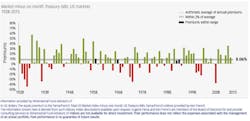Weathering the extremes of managing your wealth
Short-term wealth management isn't easy, but dentists can be successful if they think long-term
"It never rains, but it pours" is a well-worn adage, but it took on fresh meaning for me when I recently found myself parked on Highway 101 just outside of Gilroy, California, after torrential rain had flooded the road. While waiting four excruciatingly long hours for the road to reopen, I reflected on how we Californians had been conserving every precious drop of water-taking military-style, in-and-out showers and watching our yards turn to dust—while that same liquid had become so abundant that it suddenly stood between me and my home.
With all that time to think, I discovered a silver lining in my cloudy predicament: life's tendency to veer from one extreme to the other applies not only to my predicament on Highway 101, but also to the financial markets that dental professionals like you face when seeking to build your personal wealth.
When investing in the market, you can expect your "thirst" for wealth to be quenched over the long run. But it's more common for returns to be delivered in alternating droughts and deluges than as a dependable drip.
To demonstrate what I mean, we'll look at one of my favorite financial pictures, which is from Dimensional Fund Advisors and speaks volumes on this subject (figure 1).
Figure 1: Yearly observations of premiums
At a glance, you may shrug your shoulders, not unlike how I shrugged mine at the warning signs I passed and ignored as I approached that road closure, thinking—or at least hoping—they did not apply to me. (They did.)
So how does this apply to you and your money?
Let's start with the dotted line running horizontally from 1928 through 2015. It tells us that the average annual market return across this lengthy span was just over 8%. In other words, if all the market returns delivered between 1928 and 2015 had arrived in a steady, orderly pace, investors would have earned 8%, year in and year out.
Instead, as the green and red bars show us, some years rained wealth upon us while others poured money down the drain. Without any need to further analyze the precise numbers, this reality provides two important lessons about your investments:
1. Average returns are atypical. What about those four black bars in the chart? They represent the four (only four!) years that the market delivered "normal" returns that were within 2% of its long-term average. Our recent experience with California rain provides a perfect analogy. While on average, we expect around 20 inches of rain annually, that "normal" amount usually arrives as great gushes, interspersed with disappointing drizzles. As I sat there, stuck on the highway, I certainly wished it was more "normal."
2. Patience is your best bet. It's also easy to see at a glance that investors have had to endure several years of red-bar financial famine. But those years have been significantly outnumbered by green-bar years of plenty. Stick with the market over the long haul, and you can expect to come out ahead.
It's easy to reach these conclusions in hindsight. When you're living through the feast and famine that is our market, it's much harder to remain calm and consistently make decisions that are in alignment with your goals. During surging markets, it's tempting to buy more of the hottest performers—but then you're buying when supply and demand has driven up the price. When markets dive, you're tempted to sell the scariest holdings—when prices are at rock-bottom.
Buying high and selling low? Never a good strategy! Academic studies have repeatedly demonstrated that attempts to buy low and sell high actually increase the probability that you will miss out on that long-term average, which could have been yours simply by remaining in your seat.
When considering how to behave in the current financial climate, I recommend using this historical data as your guide. Consider it your warning sign, informing you that the best course of action is to invest in the market according to your personal goals and risk tolerances, minimize the costs involved in doing so, and then sit tight and wait for the rains to come.
Joe Kalinowski, CPA, PFS, joined Thomas, Wirig, Doll in Walnut Creek, California, in 1988. He is focused on the needs of his dental clients, and he is a frequent speaker on wealth and tax management strategies for high-net-worth individuals. He is on the board of the Academy of Dental CPAs, a national organization that represents more than 8,000 dentists (adcpa.org). Joe can be reached at [email protected] or (877) 939-2500.


